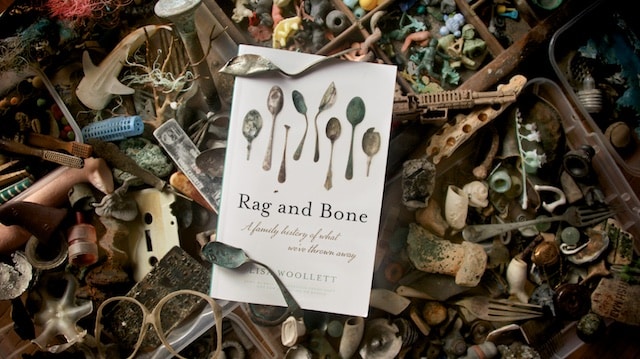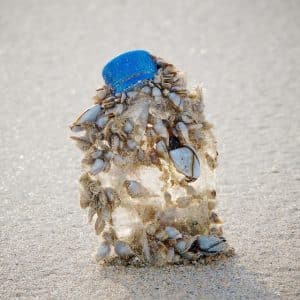Over the years I’ve found a lot of plastic army men on beaches. Most are left on the strandline at high tide, often amongst the swathes of plastic that litter Cornwall’s ‘collector’ beaches after gales. Some are whole, but many are missing heads or legs, with quite a few of them no more than wave-worn torsos. On my favourites, the chiselled, heroic features have softened over time, their expressions altered through years of abrasion.

I found the figure above almost two years ago. More recently, scrolling idly through photographs of army men, I came across one kneeling in a similar pose. It was in mint condition, with a smooth olive sheen, and captioned ‘Vintage 1960s plastic toy army radio operator’. From a few remaining details on mine – the headset and textured scarf, a gun holster and canteen on his belt – I was sure the two were once identical.
Now I could see what had been lost to the sea: bent legs and a stand, an outstretched arm resting on a bulky WW2 field radio, the handset held to his mouth. After maybe 50 or 60 years at sea and buried in sand, that raised arm means he now appears to be pleading.

On a whim, I contacted the photographer and learned he’d taken the photograph for an auction house. He said the figures were manufactured from the late 1950s through to the mid seventies, with the vast majority produced in the sixties. For although plastic soldiers were already popular in the post-war fifties, a lead poisoning scare in the sixties brought an end to traditional lead soldiers. And a surge in the popularity of the plastic army men.

As today, they were injection moulded. So like most of the plastic in our lives, army men are made from nurdles: the raw, lentil-sized plastic pellets that wash up on the strandline with them (above).

Unlike the lead soldiers, plastic army men could be bought cheaply in bags of 50, 100 or even 200. This made them more or less disposable, and so ‘infinitely destructible’: shot from bedroom windows, buried in plant pots, ‘blown up’ with bricks, catapulted over next door’s fence, left on beaches and sucked up Hoovers. They cost so little, it didn’t matter if the army men were lost.

Interestingly, despite revivals in more recent decades, the army men have never really modernised. They still strike the same classic poses – kneeling rifleman, prone sniper, grenade thrower, standing rifleman, bazooka man – in pot helmets and uniforms from the Second World War.

Although some have more modern – anachronistic – weapons, they remain in the middle of the last century: goodies and baddies, distant from the realities of more recent wars, politically safer than Vietnam or Iraq. And while the first ‘Plastic Army Women’ are due to arrive later this year, they too will strike the same classic poses, in uniforms from the Second World War.



More on the ‘Travelling Museum of Finds’ here

and reviews of Rag and Bone (John Murray, June 2020) here



